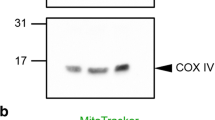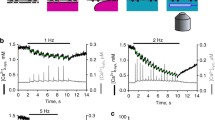Abstract
During relaxation of cardiac muscle four Ca transport systems can compete to remove Ca from the myoplasm. These are 1) the SR Ca-ATPase, 2) the sarcolemmal Na/Ca exchange, 3) the sarcolemmal Ca-ATPase, and 4) the mitochondrial Ca uniporter. Isolated ventricular myocytes loaded with the intracellular fluorescent Ca indicator indo-1 were used to study [Ca]i decline during relaxation. By selective inhibition of the various Ca transporters above the dynamic interaction of these systems during relaxation was evaluated. Quantitatively the SR Ca-ATPase and Na/Ca exchange are clearly the most important (accounting for >95% of Ca removal). However, the balance of Ca fluxes between these systems vary in a species dependent manner. For example, the SR is much more strongly dominant in rat ventricular myocytes, where ∼92% of Ca removal is via SR Ca-ATPase and only 7% via Na/Ca exchange during a twitch. In other species (rabbit, ferret, cat, and guinea-pig) the balance is more in the range of 70–75% SR Ca-ATPase and 25–30% Na/Ca exchange. Ferret ventricular myocytes also exhibit a unusually strong sarcolemmal Ca-ATPase. During the normal steady state cardiac contraction-relaxation cycle the same amount of Ca must leave the cell as enters over a cardiac cycle. This implies that 25–30% of the Ca required to activate contraction must enter the cell at each cardiac cycle. Experiments using voltage clamp to measure both Ca current and Na/Ca exchange current demonstrate that this amount of Ca may be supplied by the L-type Ca current.
The ability of the SR Ca-ATPase to reduce [Ca]i may also be modified both acutely (e.g. by catecholamines) as well as chronically (e.g. during cardiac hypertrophy and heart failure). Using tissue cultured neonatal rat ventricular myocytes, we studied the effect of chronic arrest or stimulation with phorbol esters (to stimulate protein kinase C). Verapamil-induced arrest increased the SR Ca-ATPase at the level of mRNA, protein expression and functional ability to lower [Ca]i in intact cells. Conversely, stimulation or protein kinase C reduced SR Ca-ATPase at all three of these levels.
Similar content being viewed by others
References
Bers DM (1991) Excitation-contraction coupling and cardiac contractile force. Kluwer Academic Press, Dordrecht, Netherlands, pp 1–258
Sutko JL, Willerson JT (1980) Ryanodine alteration of the contractile state of rat ventricular myocardium. Comparison with dog, cat and rabbit ventricular tissues. Circ Res 46: 332–343
Bers DM (1985) Ca influx and SR Ca release in cardiac muscle activation during postrest recovery. Amer J Physiol 248: H366-H381
Bers DM (1987) Mechanisms contributing to the cardiac inotropic effect of Na-pump inhibition and reduction of extracellular Na. J Gen Physiol 90: 479–504
Bers DM, Christensen DM, Nguyen TX (1988) Can Ca entry via Na−Ca exchange directly activate cardiac muscle contraction? J Molec Cell Cardiol 20: 405–414
Beuckelmann DJ, Wier WG (1988) Mechanism of release of calcium from sarcoplasmic reticulum of guinea pig cardiac cells. J Physiol 405: 233–255
Fabiato A (1985) Time and calcium dependence of activation and inactivation of calcium-induced release of calcium from the sarcoplasmic reticulum of a skinned canine cardiac Purkinje cell. J Gen Physiol 85: 247–290
Leblanc N, Hume JR (1990) Sodium current-induced release of calcium from cardiac sarcoplasmic reticulum. Science 248: 372–376
Levi AJ, Spitzer KW, Kohmoto O, Bridge JHB (1994) Depolarization-induced Ca entry via Na−Ca exchange triggers SR release in guinea pig cardiac myocytes. Amer J Physiol 266: H1422-H1433
Kohmoto O, Levi AJ, Bridge JHB (1994) Relation between reverse sodium-calcium exchange and sarcoplasmic reticulum calcium release in guinea pig ventricular cells. Circ Res 74: 550–554
Bassani RA, Bassani JWM, Bers DM (1992) Mitochondrial and sarcolemmal Ca transport can reduce [Ca]i during caffeine contractures in rabbit cardiac myocytes. J Physiol 453: 591–608
Bassani JWM, Bassani RA, Bers DM (1994) Relaxation in rabbit and rat cardiac cells: Species-dependent differences in cellular mechanisms. J Physiol 476: 279–293
Bassani RA, Bassani JWM, Bers DM (1994) Relaxation in ferret ventricular myocytes: Unusual interplay among calcium transport systems. J Physiol 476: 295–308
Arai M, Matsui H, Periasamy M (1994) Sarcoplasmic reticulum gene expression in cardiac hypertrophy and heart failure. Circ Res 74: 555–564
Simpson P (1985) Stimulation of hypertrophy of cultured neonatal rat cardiac cells through an α1-adrenergic receptor and induction of beating through an β1-adrenergic receptor interaction. Circ Res 56: 884–894
Bassani JWM, Qi M, Samarel AM, Bers DM (1994) Contractile arrest increases SR Ca uptake and SERCA2 gene expression in cultured neonatal rat hearts cells. Circ Res 74: 991–997
Qi M, Bassani JWM, Bers DM, Samarel AM (1996) Phorbol 12-myristate 13-acetate alters SR Ca2+-ATPase gene expression in neonatal rat heart cells. Amer J Physiol 271: H1031-H1039
Delbridge LM, Bassani JWM, Bers DM (1996) Steady-state twitch Ca fluxes and cytosolic Ca buffering in rabbit ventricular myocytes. Amer J Physiol 270: C192-C199
Bassani RA, Bassani JWM, Bers DM (1995) Relaxation in ferret ventricular myocytes: role of the sarcolemmal Ca ATPase. Pflügers Archiv 430: 573–579
Bers DM, Bridge JHB (1989) Relaxation of rabbit ventricular muscle by Na−Ca exchange and sarcoplasmic reticulum Ca-pump: Ryanodine and voltage sensitivity. Circ Res 65: 334–342
Bers DM, Bridge JHB, Spitzer KW (1989) Intracellular Ca transients during rapid cooling contractures in guinea-pig ventricular myocytes. J Physiol 417: 537–553
Hryshko LV, Stiffel VM, Bers DM (1989) Rapid cooling contractures as an index of SR Ca content in rabbit ventricular myocyte. Amer J Physiol 257: H1369–1377
Hove-Madsen L, Bers DM (1993) SR Ca uptake and thapsigargin sensitivity in permeabilized rabbit and rat ventricular myocytes. Circ Res 73: 820–828
Bassani JWM, Bassani RA, Bers DM (1993) Twitch-dependent SR Ca accumulation and release in rabbit ventricular myocytes. Amer J Physiol 265: C533-C540
Bassani RA, Bers DM (1995) Rate of diastolic Ca release from the sarcoplasmic reticulum of intact rabbit and rat ventricular myocytes. Biophys J 68: 2015–2022
Bers DM, Lederer WJ, Berlin JR (1990) Intracellular Ca transients in rat cardiac myocytes: Role of Na/Ca exchange in excitation-contraction coupling. Amer J Physiol 258: C944-C954
Bassani JWM, Yuan W, Bers DM (1995) Fractional SR Ca release is altered by trigger Ca and SR Ca content in cardiac myocytes. Amer J Physiol 268: 1313–1319
Gatto C, Milanick MA (1993) Inhibition of the red blood cell calcium pump by eosin and other fluorescein analogues Am J Physiol 264: C1577-C1586
Gatto C, Hale CC, Milanick MA (1995) Eosin, a potent inhibitor of the plasma membrane Ca pump, does not inhibit the cardiac Na−Ca exchanger. Biochemistry 34: 965–972
Hove-Madsen L, Bers DM (1993) Passive Ca buffering and SR Ca uptake in permeabilized rabbit ventricular myocytes. Amer J Physiol 264: C677-C686
Negretti N, O'Neill SC, Eisner DA (1993) The relative contributions of different intracellular and sarcolemmal systems to relaxation in rat ventricular myocytes. Cardiovasc Res 27: 1826–1830
Crespo LM, Grantham CJ, Cannell MB (1990) Kinetics, stoichiometry and role of the Na−Ca exchange mechanism in isolated cardiac myocytes. Nature 345: 618–621
de la Bastie D, Levitsky D, Rappaport L, Mercadier J-J, Marotte F, Wisnewsky C, Brovkovich V, Schwartz K, Lompré A-M (1990) Function of the sarcoplasmic reticulum and expression of its Ca2+-ATPase gene in pressure overload-induced cardiac hypertrophy in the rat. Circ Res 66: 554–564
Hasenfuss G, Reinecke H, Studer R, Meyer M, Pieske B, Holubarsch C, Posival H, Just H, Drexler H (1994) Relation between myocardial function and expression of sarcoplasmic reticulum Ca2+-ATPase in failing and non-failing human myocardium. Circ Res 75: 434–442
Samarel AM, Engelmann GL (1991) Contractile activity modulates myosin heavy chain-β expression in neonatal rat heart cells. Am J Physiol 261: H1067-H1077
Toaldo G-L, Hefner CA, Bailey BA, Houser SR (1995) Reduced SERCA expression correlates with prolongation of the systolic Ca2+ transient in hypertrophy hypertrophied neonatal rat ventricular myocytes. Biophys J 68: A311
Boerth SA, Zimmer DB, Artman M (1994) Steady state mRNA levels of the sarcolemmal Na+−Ca2+ exchanger peak near birth in developing rat and rabbit hearts. Cir Res 74: 354–359
Kaufman TM, Horton JW, White DJ, Mahony L (1990) Age-related changes in myocardial relaxation and sarcoplasmic reticulum function. Am J Physiol 259: H309–316
Artman M, Ichikawa H, Avkiran M, Coetzee WA (1995) Na+/Ca2+ exchange current density in cardiac myocytes from rabbits and guinea-pigs during postnatal development. Am J Physiol 268: H1714-H1722
Studer R, Reinecke H, Bilger J, Eschenhagen T, Böhm M, Hasenfuss G, Just H, Drexler H (1994) Gene expression of the cardiac Na+−Ca2+ exchanger in end-stage human heart failure. Circ Res 75: 443–453
Kent RL, Rozich JD, McCollam PL, McDermott DE, Thacker UF, Menick DR, McDermott PJ, Cooper GIV (1993) Rapid expression of the Na+−Ca2+ exchanger in response to cardiac pressure overload. Am J Physiol 265: H1024-H1029
Fabiato A (1983) Calcium-induced release of calcium from the cardiac sarcoplasmic reticulum. Amer J Physiol 245: C1-C14
Author information
Authors and Affiliations
Rights and permissions
About this article
Cite this article
Bers, D.M. Ca transport during contraction and relaxation in mammalian ventricular muscle. Basic Res Cardiol 92 (Suppl 1), 1–10 (1997). https://doi.org/10.1007/BF00794062
Issue Date:
DOI: https://doi.org/10.1007/BF00794062




